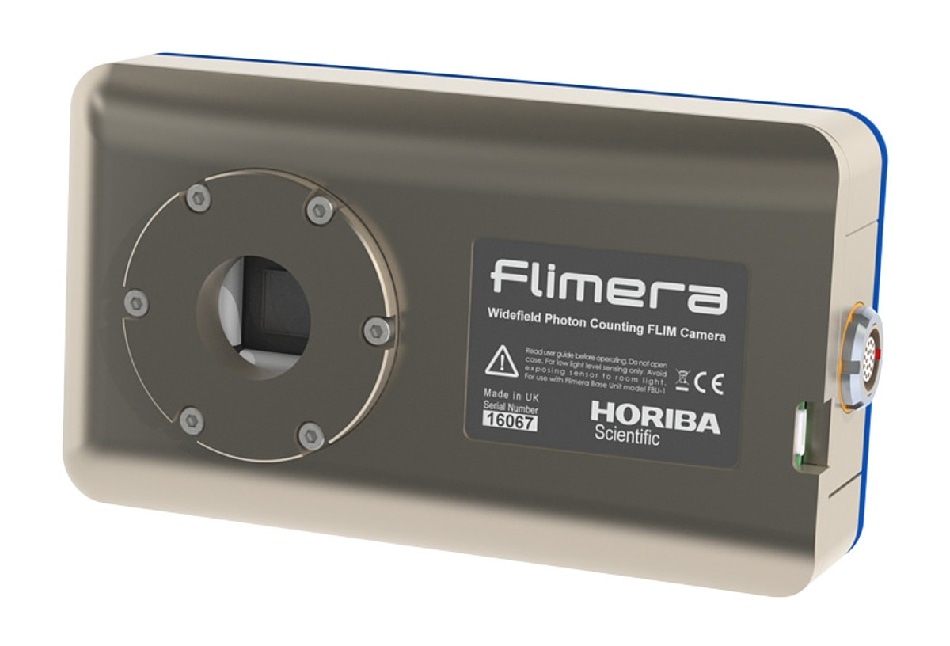
HORIBA Scientific, a global leader in Fluorescence solutions, announces a new camera for microscopic research inside cells and detection of biomarkers for disease diagnostics. Developed by Glasgow-based company HORIBA Jobin Yvon IBH, the FLIMERA is a CMOS-based FLIM camera that enables fluorescence lifetime data obtained via TCSPC in each individual pixel. It uses a 192 x 128 array of single photon avalanche diodes (SPADs), each with its own time to digital converter (TDC), for up to 24,576 simultaneous lifetime measurements with a time range from 200 ps to 200 ns nominal with 4096 time bins (<50ps per bin).
The HORIBA FLIMera imaging camera acquires the time decay of laser-excited fluorescence at video rate speeds, compared to conventional fluorescence microscopes, which measure the intensity of light to obtain contrast.
This innovative TCSPC camera offers the possibility of sample analysis with up to 5 exponential decays for each individual pixel, for complex and sophisticated molecular analysis. A dynamic video feature allows real time video rate (30fps) FLIM to be recorded or streamed to a HDF5 file format, facilitating the ability to study FLIM dynamics of biologically important events.
The camera has a “C mount” to attach to a microscope and accepts TTL synchronization signals up to 100MHz. The frame rate will be dependent on the photon flux and the processing ability of the control computer, but 30Hz FLIM images have been demonstrated.
The FLIM camera uses EzTime Image, part of HORIBA’s EzTime software for instrument control, data acquisition and analysis. Together, they perform Fluorescence Lifetime Imaging on different microscope-based platforms, and provide more information than traditional EMCCD or intensified fluorescence imaging cameras to elucidate complex and dynamic molecular interactions exploiting the sensitivity of TCSPC fluorescence techniques.
FLIMera is another groundbreaking technology from our TCSPC center of excellence in Glasgow, Scotland, which is in its fourth decade of TCSPC systems and components development. This TCSPC based imaging camera, combined with EzTime Image software and our wide range of laser sources opens the door to revealing new information on dynamic molecular processes that are fundamental to human metabolism and health, including cancer detection, and rapid screening in disease diagnostics.
Cary Davies, Global Product Line Manager, Fluorescence Division, HORIBA Scientific.
HORIBA’s FLIMERA camera also has applications in cancer screening, but its underlying technology is based on fluorescence lifetime imaging microscopy (FLIM). Managing director, Dr. David McLoskey described this technique as, “a way of looking at stored energy in molecules,” adding that the length of time between when a molecule absorbs a photon and when it radiates the energy away is an important probe for interactions between cells and proteins. HORIBA’s device incorporates advanced software that enables videos of molecular interactions to be displayed and recorded at a rate of 30 frames per second.
Originally spun-out from the University of Strathclyde’s Department of Physics, the company has also brought on board the University of Edinburgh in a recent program supported by QuantIC; the UK Quantum Technology Hub in Quantum Enhanced Imaging.
The Flimera camera was recognized recently with the Institute of Physics Business Innovation Award presented at the Palace of Westminster. Dr. David McLoskey received the award and commented, “It is an honor to receive this prestigious award as recognition of the dedication of the whole team in bringing this exciting development to fruition.”
For information on the Business Innovation Award: https://physicsworld.com/a/engines-and-imagers-dominate-awards-for-physics-based-innovations/.